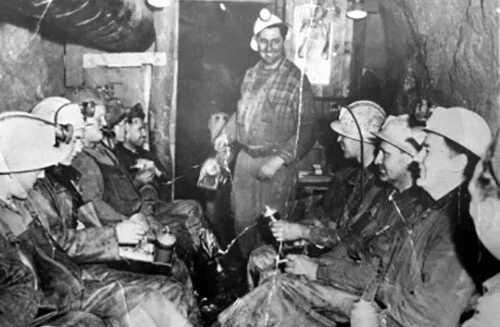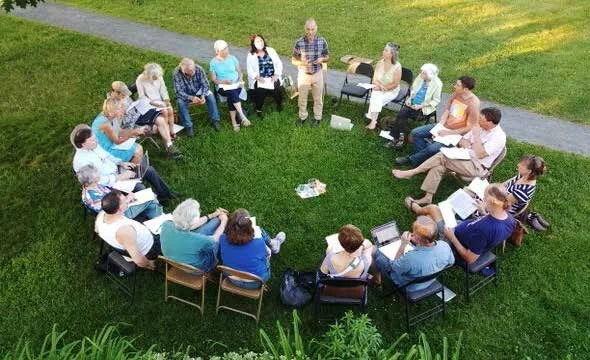Mine Cleanup Weeks From Finished, EPA Project Took 22 Years
Horse hauling ore and miner on trestle. (Provided / Strafford Historical Society)
After 22 years, the Elizabeth Mine Superfund cleanup is almost complete. The project, originally estimated to cost $15 million, will end with a price tag of approximately $90 million dollars, according to the Environmental Protection Agency’s remedial project manager Ed Hathaway, who has lead the cleanup since it began.
The bridge deck off Tyson Road is expected to be complete by the end of this month, apart from guardrails which are in short supply and expected in August.
The other project finishing up at the site is the closing of an entrance to the mine— known as an adit—which dates back to 1898. Workers are installing a concrete plug to prevent impounded water from escaping the mine and forming a sinkhole in the road, as it did in 2018.
As the EPA finishes up, maintenance is to be handed off to the state. Costs will be low, explained Hathaway, because active treatment systems have been replaced with long-term, passive, gravity-operated treatment systems for the leaching runoff. Runoff passes through a limestone filter and then filtrates through a marsh until entering the Ompompanoosuc with safe levels of all contaminants, said Hathaway.
The present-day mine site hosts a large solar array. (Provided / Todd Binzen)
In some ways, this year marks the end of the rich mine’s lifecycle that began with the discovery of ore in 1793.
The Elizabeth Mine had nine distinct smelting campaigns. It operated off and on from 1809 to 1958, first for iron, then for an iron sulfate known as copperas. In 1880, the mine produced 80% of the nation’s copperas, a mineral used for making medicines and tanning leather, among other things. The mine shifted to copper as demands changed.
In the early days, mining was done by hand and lit by candle. Miners were mostly immigrants from Ireland and Cornwall, England. Some men began working at age 10 or younger. Injuries and accidents were common.
With each new operation of the mine, new technologies were added such as electric mine carts, headlamps, and power drills, which made the mine increasingly more productive and safer for miners.
Miners enjoying lunch underground during the 1942-1958 revival. At this point hard hats had replaced leather caps, and headlamps had replaced candles. (Provided / University of Vermont Archives)
The final campaign coincided with World War II and the Korean War, running from 1943-1958. As the largest copper mine in New England at the time, the Elizabeth Mine played an integral part in supplying the war efforts. Among other uses, copper was a critical resource to the burgeoning air force of the era—1,000 pounds of copper were required for a single fighter plane.
In total, miners extracted approximately 100 million pounds of copper.
A Big Impact
The mine “meant almost everything. It was an economic engine for the community, there’s no doubt about it,” said Bob Johnston, the previous town historian in Strafford.
When the mines closed for the last time, 47 acres of waste material remained— about 4 million tons of toxic tailings.
In 1996, a study group formed to assess the environmental impacts. A U.S. geological survey found that every day 500 pounds of metals were draining from the mine site directly into the Ompompanoosuc River and, from there, the Connecticut eight and a half miles downstream.
Water leaching from the site was measured with a pH of one—equivalent to human stomach acid.
These metals made the Ompompanoosuc inhospitable to marine life for five miles. If the tailings were left untouched, they would pollute the local ecosystem for hundreds of years. Due to the scale of the issue, the state requested that the EPA get involved.
By that point none of the mining companies still existed, meaning that no one could be held responsible for the environmental degradation.
There was heated debate in Strafford at the time over whether or not to accept the Superfund. Some felt it was an oversized solution.
At the time, John Freitag, the town historian, described it as using a sledgehammer to do finish carpentry.
The Superfund Program itself had begun in 1986 by taxing oil and gas companies, and using the money to clean up areas degraded by the fossil fuel industry. However, when the tax expired in 1995 it was not reinstated, and taxpayers have funded these clean-ups ever since.
Townspeople approved the Elizabeth Mine Superfund project on Town Meeting Day in 2003, and work began.
Very quickly, problems were discovered which extended the project. A dam holding back millions of gallons of water had been built out of tailing material and was on the verge of collapse, threatening 11 homes and disastrous impacts to the surrounding environment. Stabilizing the dam took priority.
“If we hadn’t gotten the dam stabilized before Tropical Storm Irene, there could have been some pretty serious consequences,” noted Hathaway.
Balancing Restoration
As the work went on it gave rise to opportunity. In 2017, Strafford’s energy committee worked with Greenwood Energy to install a 7mW solar array on top of the 45-acre cap that had been built to prevent the toxic tailings from leaching into the surrounding water supply. The array provides enough energy to power 1,333 homes.
One difficulty that faced the project was that the mine is considered a historical site in the National Register of Historic Places due to its impact on the landscape and industrial history. Even the tailings dam on the brink of collapse was considered a historical structure.
“It’s hard to say now that the mine was ever there,” said Johnston. “It’s been so well remediated.”
The history of the site is being preserved in some of the buildings and foundations that have been left as a way to interpret the site in the future, said Hathaway. Folks working on the project have also produced historic documents on the mine, working with historians throughout the cleanup process.
Johnston said there was a private effort to open a mining museum near the site, though it’s too early in the process to know if that will come to fruition.
Freitag followed the work closely throughout. While he thought it was good the site was cleaned up, he maintained some reservations.
“What was hard for me was, you can never treat any problem in isolation. Because it was an emergency cleanup, there was never any environmental impact study. You had between 20- and 30-thousand 10-wheel dumptruck loads of material coming to the site. There was no thought of the carbon footprint of this.”
Industrial sites at such a scale are unusually large for the area and the Elizabeth Mine had a big impact on the region. Even now, remediated and laid to rest, it demonstrates a history of humankind’s effect on the land.
To view published article in The Herald, click here.










